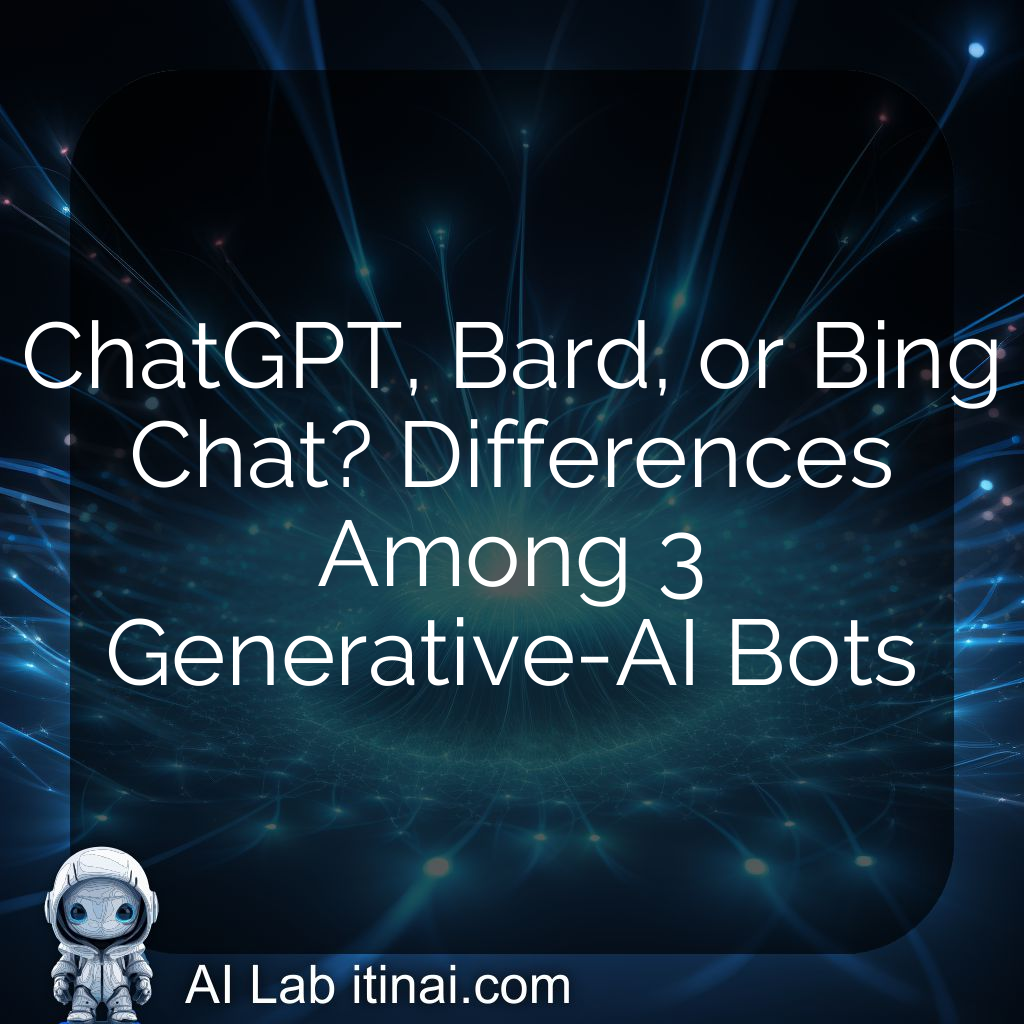Summary: ChatGPT and Bard were rated as more helpful and trustworthy than Bing Chat in a diary study evaluating the three generative-AI bots. Bing Chat’s less favorable ratings were attributed to its richer yet imperfect user interface and poorer information aggregation capabilities.
Summary: Participants rated Bing Chat as less helpful and trustworthy than ChatGPT or Bard. These results can be attributed to Bing’s richer yet imperfect UI and its poorer information aggregation.
One of the benefits of generative-AI bots is that they save users the effort of searching for information themselves. They aggregate relevant information from various sources, making it easier for users to find what they need.
In a diary study that involved three bots, we discovered that people overwhelmingly found the conversations with these bots to be highly helpful and trustworthy. However, there were some discrepancies in the ratings for the three bots, which can be explained by their differing capacities and interfaces.
Our Research:
Action Items:
1. Conduct further research on the interface and information aggregation capabilities of ChatGPT, Bard, and Bing Chat to gain a deeper understanding of the differences mentioned in the meeting notes.
2. Analyze user feedback and ratings for ChatGPT, Bard, and Bing Chat to identify specific areas where improvements can be made.
3. Collaborate with the UI/UX team to address any issues related to Bing Chat’s user interface, aiming to make it more user-friendly and intuitive.
4. Explore ways to enhance Bing Chat’s information aggregation process to improve its effectiveness and accuracy.
5. Schedule a meeting with the development team to discuss potential updates or new features that can bridge any gaps and address the shortcomings highlighted in the meeting notes.
Assignments:
1. Research task (Action Item 1) – Assigned to [Researcher]
2. User feedback analysis (Action Item 2) – Assigned to [Data Analyst]
3. UI/UX improvements (Action Item 3) – Assigned to [UI/UX Designer]
4. Information aggregation enhancement (Action Item 4) – Assigned to [Development Team Lead]
5. Meeting scheduling and follow-up (Action Item 5) – Assigned to [Executive Assistant]Please review and let me know if any adjustments or clarifications are needed.
List of Useful Links:
AI Products for Business or Custom Development

AI Sales Bot
Welcome AI Sales Bot, your 24/7 teammate! Engaging customers in natural language across all channels and learning from your materials, it’s a step towards efficient, enriched customer interactions and sales

AI Document Assistant
Unlock insights and drive decisions with our AI Insights Suite. Indexing your documents and data, it provides smart, AI-driven decision support, enhancing your productivity and decision-making.

AI Customer Support
Upgrade your support with our AI Assistant, reducing response times and personalizing interactions by analyzing documents and past engagements. Boost your team and customer satisfaction

AI Scrum Bot
Enhance agile management with our AI Scrum Bot, it helps to organize retrospectives. It answers queries and boosts collaboration and efficiency in your scrum processes.
AI Agents
AI news and solutions
-
Aya Vision: Revolutionizing Multilingual AI Communication
Cohere For AI Launches Aya Vision: A New Era in Multilingual and Multimodal Communication Cohere For AI has introduced Aya Vision, an innovative open-weights vision model designed to enhance multilingual and multimodal communication. This advancement aims…
-
Simular Agent S2: The Future of AI-Powered Computer Automation
Enhancing Digital Interactions with Agent S2 In today’s digital age, users often struggle with complex software and operating systems. Navigating intricate interfaces can be tedious and prone to error, leading to inefficiencies in routine tasks. Traditional…
-
Google AI Launches Gemini Embedding: Next-Gen Multilingual Text Representation Model
Recent Advancements in Embedding Models Recent advancements in embedding models have focused on enhancing text representations for various applications, including semantic similarity, clustering, and classification. Traditional models like Universal Sentence Encoder and Sentence-T5 provided generic text…
-
Alibaba’s R1-Omni: Advanced Reinforcement Learning for Multimodal Emotion Recognition
Challenges in Emotion Recognition Emotion recognition from video poses various complex challenges. Models relying solely on visual or audio signals often overlook the intricate relationship between these modalities, resulting in misinterpretation of emotional content. A significant…
-
Revolutionizing Robotic Manipulation with DEMO3: Overcoming Sparse Rewards and Enhancing Learning Efficiency
“`html Challenges in Robotic Manipulation Robotic manipulation tasks present significant challenges for reinforcement learning. This is mainly due to: Sparse rewards that limit feedback High-dimensional action-state spaces Difficulty in designing effective reward functions Conventional reinforcement learning…
-
Build an Interactive Bilingual Chat Interface with Meraj-Mini AI
Bilingual Chat Assistant Implementation In this tutorial, we will implement a Bilingual Chat Assistant using the Meraj-Mini model from Arcee AI. The assistant will be seamlessly deployed on Google Colab using T4 GPU, demonstrating the capabilities…
-
R1-Searcher: Enhancing LLM Search Capabilities with Reinforcement Learning
Improving Large Language Models with R1-Searcher Large language models (LLMs) rely heavily on their internal knowledge, which often falls short when faced with real-time or complex inquiries. This shortcoming can lead to inaccurate responses or “hallucinations.”…
-
HybridNorm: Optimizing Transformer Architectures with Hybrid Normalization Strategies
Transforming Natural Language Processing with HybridNorm Transformers have significantly advanced natural language processing, serving as the backbone for large language models (LLMs). They excel at understanding long-range dependencies using self-attention mechanisms. However, as these models become…
-
Google AI Launches Gemma 3: Efficient Multimodal Models for On-Device AI
Challenges in Artificial Intelligence Artificial intelligence faces two significant challenges: high computational resource requirements for advanced language models and their unsuitability for everyday devices due to latency and size. Moreover, ensuring safe operation with proper risk…
-
Build an Interactive Health Monitoring Tool with Bio_ClinicalBERT and Hugging Face
“`html Building an Interactive Health Data Monitoring Tool In this tutorial, we will develop a user-friendly health data monitoring tool utilizing Hugging Face’s transformer models, Google Colab, and ipywidgets. This guide will help you set up…
-
Hugging Face Launches OlympicCoder: Advanced Open Reasoning AI for Olympiad-Level Programming
Challenges in Competitive Programming In competitive programming, both human competitors and AI systems face unique challenges. Many existing AI models struggle to solve complex problems consistently. A common issue is their difficulty in managing long reasoning…
-
Limbic AI Enhances Cognitive Behavioral Therapy Outcomes with Generative AI Tool
Advancements in Generative AI in Healthcare Recent advancements in generative AI are revolutionizing healthcare, particularly in mental health services, where engaging patients can be challenging. A recent study published in the Journal of Medical Internet Research…
-
Evolving Large Language Models: The GENOME Approach for Dynamic Adaptation
Transforming AI with Large Language Models Large language models (LLMs) have revolutionized artificial intelligence by excelling in tasks like natural language understanding and complex reasoning. However, adapting these models to new tasks remains a challenge due…
-
Reka Flash 3: Open Source 21B General-Purpose Reasoning Model for Efficient AI Solutions
Challenges in the AI Landscape In the evolving AI environment, developers and organizations encounter several challenges. Issues such as high computational demands, latency, and limited access to adaptable open-source models often hinder progress. Many existing solutions…
-
Implementing Text-to-Speech with BARK in Google Colab using Hugging Face
“`html Text-to-Speech Technology Overview Text-to-Speech (TTS) technology has significantly advanced, evolving from robotic voices to highly natural speech synthesis. BARK, developed by Suno, is an open-source TTS model that generates human-like speech in multiple languages, including…
-
Enhancing LLM Reasoning with Multi-Attempt Reinforcement Learning
Enhancing LLM Reasoning with Multi-Attempt Reinforcement Learning Recent advancements in reinforcement learning (RL) for large language models (LLMs), such as DeepSeek R1, show that even simple question-answering tasks can significantly improve reasoning capabilities. Traditional RL methods…
-
RL-Enhanced QWEN 2.5-32B: Advancing Structured Reasoning in LLMs with Reinforcement Learning
Introduction to Large Reasoning Models Large reasoning models (LRMs) utilize a structured, step-by-step approach to problem-solving, making them effective for complex tasks that require logical precision. Unlike earlier models that relied on brief reasoning, LRMs incorporate…
-
STORM: Revolutionizing Video Understanding with Spatiotemporal Token Reduction for Multimodal LLMs
Understanding AI in Video Processing Efficiently handling video sequences with AI is crucial for accurate analysis. Current challenges arise from models that fail to process videos as continuous flows, leading to missed motion details and disruptions…
-
Length Controlled Policy Optimization for Enhanced Reasoning Models
Enhancing Reasoning Models with Length Controlled Policy Optimization Reasoning language models have improved their performance by generating longer sequences of thought during inference. However, controlling the length of these sequences remains a challenge, leading to inefficient…
-
Revolutionizing Code Generation with µCODE: A Single-Step Multi-Turn Feedback Approach
Challenges in Code Generation Generating code with execution feedback is challenging due to frequent errors that necessitate multiple corrections. Current approaches struggle with structured fixes, leading to unstable learning and poor performance. Current Methods and Their…
